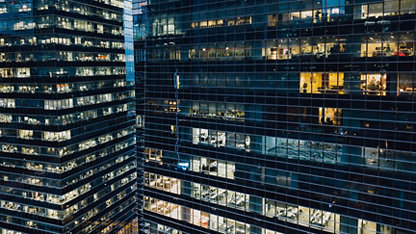Vighnesh Daas
Look around you. Are you sat in a building of some sort? Or reading this to keep yourself occupied on public transportation? It is safe to say, we spend most of our daily lives in the built environment.
I do not want to bore you with numbers and stats like manufacturing of concrete leads to 8% of global CO2 emissions annually. Every other academic research paper on concrete in the last decade has started off with that phrase. However, a statistic that is equally interesting and worrying is this -
According to the United Nations Environment Programme, 2022, global construction industry is responsible for 37%* of greenhouse gas emissions, yet only 5% of global Venture Capital investment is directed towards innovations in this sector.
So, what are the drivers to address these stats?
Well, number one should be because we want to build sustainably as these resources are finite. But also, a key factor has been COP21. Addressing climate change has been top of the agenda since 2015 with the Paris agreement driving policy in nations across the world to achieve net-zero emissions. This has led investors and policymakers frantically shift their focus to this “new” wave of opportunities to find and support innovations that address sectors heavily contributing to global emissions. A lot of that has gone to mobility, energy, and financial services whilst the built environment which is “hard to abate” remains critically under-funded. Although, according to PWC’s “State of Climate Tech,” 2023 report, investors are narrowing their focus on “heavy” or “foundation” industries to hold the rise in global temperatures to 1.5 Celsius.
Speaking to several investors in this sector, common feedback has been - “Built environment lacks scalable solutions which will give significant returns in the short-term.” I agree. This is an industry which has been using ‘Ordinary Portland Cement’ from the beginning of the 18th century. The supply chain and infrastructure are legacy, and disruption is not seen as favourable. Incumbents thrive on cashflow and spend highly on maintenance and making sure they can supply to the growing needs of the 21st century.
However, it is not all doom and gloom. Let us take the example of Ground Granulated Blast Slag (GGBS) from the steel industry and Pulverised Fuel Ash (PFA) from coal plants. The industry adopted them as solutions to lower embodied carbon of concrete and offer other benefits like better finish and sulphate resistance. With steel and coal plants in Europe being shut, rising import costs and the new EU “carbon tax” on the horizon, those are no longer local, viable and sustainable options. At least here in the west.
So, what are the innovations out there offering hope and alternatives?
- Waste valorisation: Construction demolition aggregates, bottom ash from biomass furnaces, wind turbine blades as fibre reinforcement are some examples of tinkering the supply chain to add value through circular concepts without disruptions. These technologies utilise “waste” from other industries to add intrinsic value to building materials. Companies: Coomtech, Ecolocked and Carbon Upcycling Technologies.
- Advanced composite materials: Providing excellent mechanical properties, with lightweight and greater flexibility, they are a great alternative to steel as reinforcement. The UK has led in this space through Graphene and Basalt is another popular option in concrete reinforcement. Companies: Orlimex and Concretene.
- Bio-based technologies: There is a new generation of materials being derived from nature using biotechnology which can heal cracks in concrete, grow limestone, use fungi to provide insulation for structures. These processes tend to have lower environmental impact as compared to existing ones on the market. As we run out of current resources, they will be key to plugging the gap between supply and demand. Companies: Basilisk, Biozeroc, and Mykor.
- Nature based designs: Biomimicry has long been used by the aerospace industry to break technological barriers. Now it is being used by architects and engineers in construction to mimic strength, flexibility and sustainability found in natural systems. This can range from enhancing biodiversity on coastal structures to creating artificial reefs. Companies: Archireef, Econcrete and Mimicrete.
- Carbon Capture, Utilisation and Storage (CCUS): A lot of buzz has been created in the last few years by this segment. Building materials sector has also seen a boom in this technology. Early-stage startups are capturing emissions from existing cement factories. Some are even using the captured CO2 in curing of concrete as an additional benefit. Companies: Svante, Cocoon Carbon and Concrete4Change.
Whilst this is by no means an exhaustive list of either tech or companies in this space, it shows the potential and growth in the number of innovations and themes in this sector. “Greening the grey” is a key challenge when the world is poised to build double the buildings there are today. That is the equivalent of adding a New York city every month for the next 40 years. For that reason, institutions like RICS, ICE, IStructE are key to driving collaboration in this ecosystem.
I have not delved into the challenges facing the adoption of new innovations in the building materials industry as that is a whole another article. However, the main one is increasing awareness of the existence of innovative technologies and improved processes to specifiers, asset managers and owners to help them achieve their net-zero targets. Hopefully, this article will give an insight into the scale of development of sustainable technologies in the built environment that goes beyond academic research.
Vighnesh is a Co-Founder and Director of Sensicon Ventures who established the consultancy to connect the digital and sustainable construction ecosystem including universities, start-ups, investors, and industry. He has represented the UK in multiple trade missions, advised accelerators, as well as attained multi-million-pound funding to scale innovations. After setting up concrete factories, he has successfully launched innovative products into the construction supply chain which have helped protect against flooding, increased biodiversity, and lower embodied carbon of projects in the UK.













